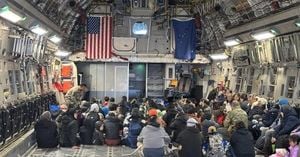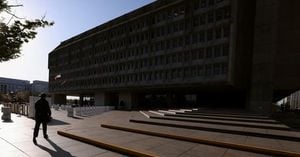The Caribbean has become the stage for a dramatic convergence of energy diplomacy, military maneuvering, and shifting geopolitical alliances as the region faces crises not seen in decades. In October 2025, two parallel developments—Mexico’s reported $3 billion subsidized fuel transfer to Cuba and an unprecedented U.S. military buildup near Venezuela—underscore the complex interplay between economic survival and political power in Latin America.
According to recent reports, Mexico is allegedly sending $3 billion worth of subsidized fuel to Cuba over a concentrated four-month operation. This initiative, if confirmed, would represent one of the largest single acts of energy assistance in the region’s recent history. The operation reportedly leverages Mexico’s state-controlled energy infrastructure, with major Gulf Coast ports such as Coatzacoalcos, Veracruz, and Tampico serving as key logistical hubs. The product mix—gasoline, diesel, and heavy fuel oil—has been tailored to meet the urgent needs of Cuba’s ailing energy infrastructure, which has been plagued by aging power plants, transportation disruptions, water distribution failures, and chronic industrial slowdowns, as documented by international organizations throughout 2024 and 2025.
The financial implications for Mexico are substantial. The $3 billion commitment equates to roughly 60 billion Mexican pesos, a sum that stands out even against Mexico’s federal budget allocations. As reported by industry analysts, such a transfer would stress Pemex’s already burdened finances and raise questions about the long-term sustainability of subsidized fuel programs. The operation’s scale also highlights Mexico’s ambition to play a larger role in regional energy security, particularly as shifting global trade dynamics and tariffs have made traditional partnerships less predictable.
However, the operation’s very existence and details remain subject to verification. As noted by energy sector observers, confirmation would require official statements from the Mexican and Cuban governments, U.S. Treasury Department sanctions guidance, port authority shipping records, and independent maritime tracking data. The Office of Foreign Assets Control (OFAC) oversees strict sanctions on energy trade with Cuba, and several vessels previously sanctioned for transporting Venezuelan oil continue to operate in regional waters, complicating compliance and transparency efforts. Customs reporting reliability, Cuban storage capacity, and the ultimate use of the petroleum products all remain open questions, as highlighted by both Mexican and international analysts.
The urgency of this alleged fuel transfer is underscored by Cuba’s deepening energy crisis. Throughout 2024 and into 2025, the island’s energy sector has suffered from frequent blackouts, transportation bottlenecks, and interruptions to essential services like water distribution. These challenges have been widely reported by independent news organizations and confirmed by international agencies. For Cuba, external fuel assistance has become not just a matter of economic convenience, but of national survival.
Mexico’s energy diplomacy in this context reflects a delicate balancing act. On one hand, the López Obrador administration (and its successors) seek to maintain a leadership position in Caribbean and Latin American affairs, offering support to neighbors in need and building goodwill. On the other, Mexico must navigate the ever-present shadow of U.S. regulatory oversight and the risk of antagonizing Washington, especially as U.S. foreign policy in the region has taken a more muscular turn.
That turn has become starkly visible in the waters off Venezuela, where the U.S. has deployed over 4,000 Marines, eight warships, combat drones, and P-8 reconnaissance aircraft in what analysts describe as the most significant American military buildup in the Caribbean since the 1989 Panama crisis. Officially, the mission is to combat drug trafficking, particularly targeting the so-called “Cartel of the Suns”—a network allegedly led by Venezuelan military leaders and President Nicolás Maduro, with support from the Cuban regime. However, diplomatic sources and military experts suggest the operation is equally intended to isolate and pressure Maduro’s embattled government.
In response, President Maduro has activated a “special territorial defense plan,” mobilizing over 4.5 million militia members and ordering missile exercises on La Orchila Island. The regime’s anxiety is palpable, but its international support appears to be waning. Neither Russia nor China, Venezuela’s main allies, have shown any willingness to intervene militarily. As exiled Nicaraguan journalist Arturo McFields observed in The Hill, “Maduro’s regime stands alone and cornered. The loyalty of Venezuelan military forces is crumbling, and not even Cuban advisors can prevent the inevitable.”
The Trump administration’s approach, dubbed “Américas First,” marks a decisive shift in U.S. regional priorities. Secretary of Defense Pete Hegseth was blunt: “We will track, kill, and dismantle their networks throughout the hemisphere.” The White House has framed the campaign as a “non-international armed conflict” against narco-terrorist organizations, seeking to rally regional allies like Colombia, Panama, and the Dominican Republic to its cause. The operation has reportedly curtailed maritime drug trafficking and reduced the financial resources flowing to the Cartel of the Suns, undermining a key economic pillar of Chavismo.
Amid these high-stakes developments, the region’s political landscape is also shifting. Venezuelan opposition leader María Corina Machado, recently awarded the Nobel Peace Prize, has been recognized for her leadership in the civil resistance against the Chavista regime. Her recognition has invigorated the democratic movement within and outside Venezuela at a time when the regime’s collapse seems increasingly likely. As McFields put it, “Peace can only be achieved through strength. The dictator’s days are numbered.”
The next 90 days, analysts agree, will be crucial for Venezuela’s future and the broader stability of the Caribbean. The combination of economic sanctions, diplomatic isolation, and now military pressure is squeezing the Maduro regime from all sides. Meanwhile, Mexico’s alleged fuel diplomacy with Cuba, if confirmed, could signal a new era of regional cooperation—or a new flashpoint in hemispheric tensions.
Amid these uncertainties, the Caribbean’s energy future may ultimately depend on broader trends toward renewable energy. Solar, wind, and hydroelectric projects are gaining momentum across the region, offering a potential long-term alternative to the petroleum-based transfers that have defined past cooperation. Mexico and Cuba, through expanded or emergency arrangements, could play pivotal roles in a new wave of regional integration—if they can navigate the minefield of sanctions, verification, and shifting alliances.
For now, the Caribbean remains a place where energy flows, military deployments, and political fortunes are all in flux, watched closely by governments, investors, and ordinary citizens alike. The decisions made in the coming months will shape not only the fate of embattled regimes, but the very structure of regional security and cooperation for years to come.




